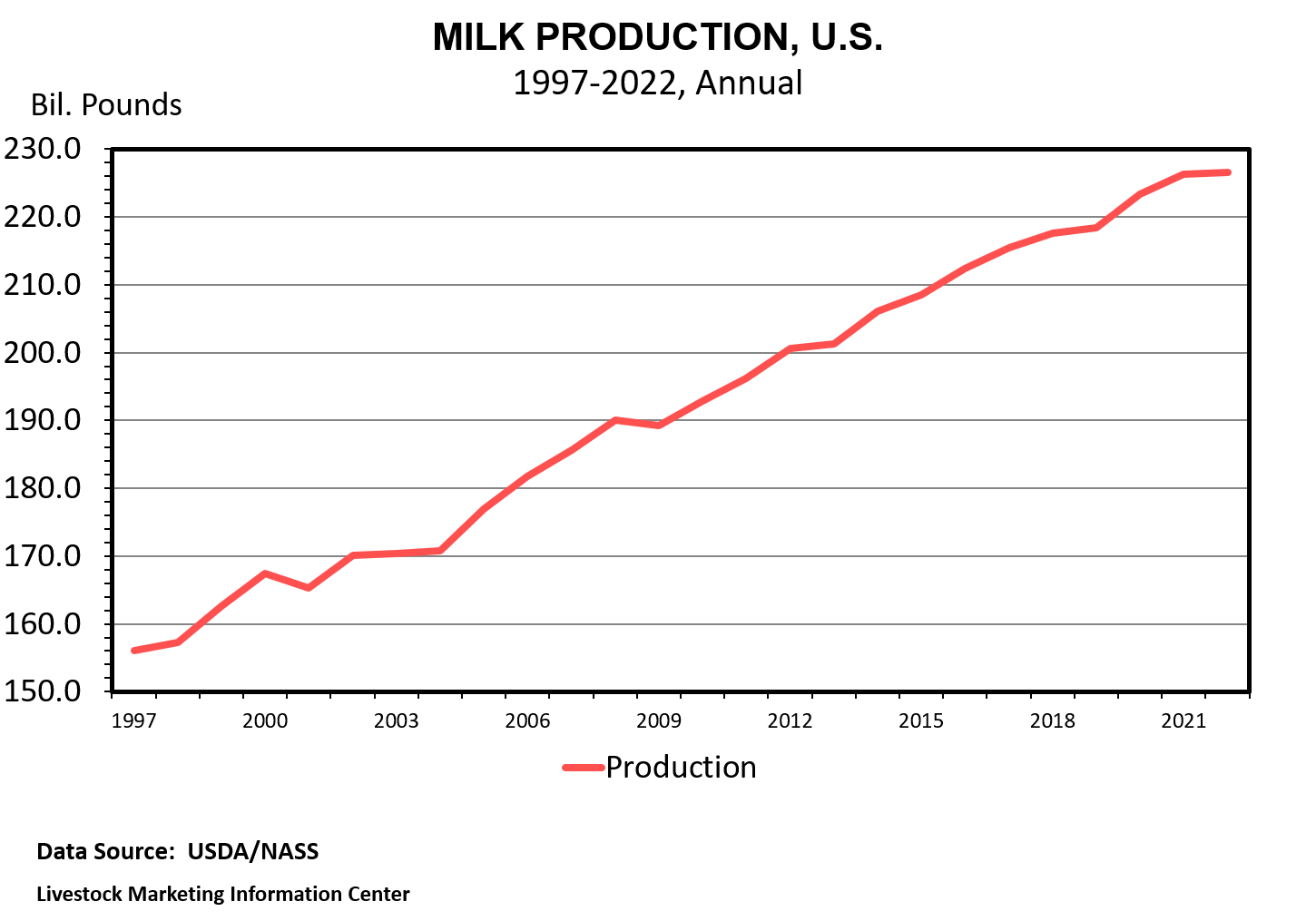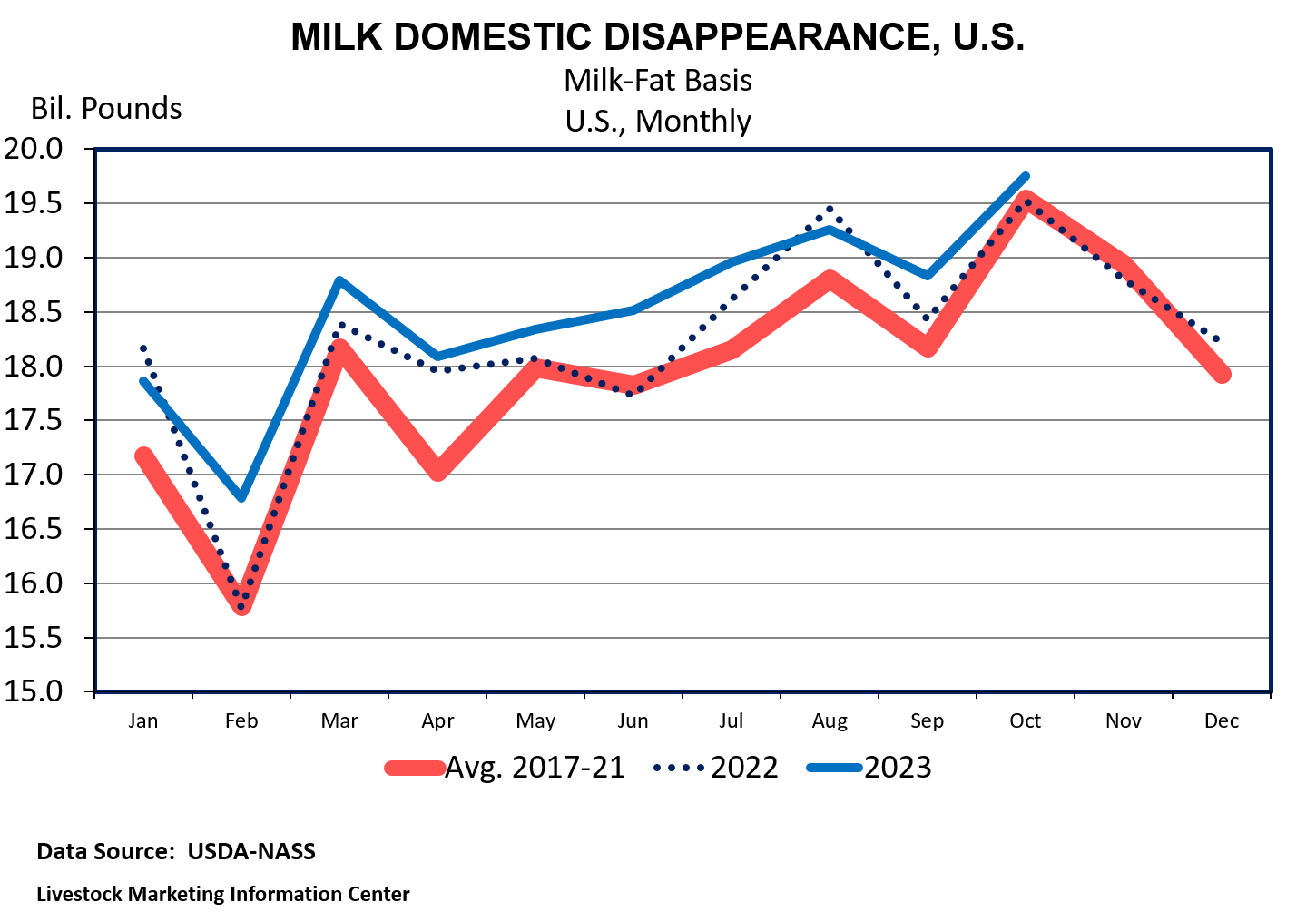Main Takeaways
- After a rough 2023, the 2024 outlook is an improvement as feed costs appear to be declining and milk prices remain stable.
- Risks remain in the balance between supply and demand as improved margins may spur a strong production response and demand growth is uncertain both domestically and overseas.
- Overall, milk prices will likely remain at similar levels in 2024 as milk production has been curtailed and demand remains stable or grows.
2024 Dairy Outlook
The dairy outlook for 2024 is a slightly better year than 2023. This improvement likely comes from a combination of lower input costs and stable to higher prices. However, several headwinds are appearing on the horizon.
Dairy margins dropped to some of the worst since the start of the Dairy Margin Coverage Program, with June and July margins dropping to less than $4/cwt. Dairy production has been increasing slightly every year for more than 10 years (see Figure 1). Expectations for 2023 are similar, despite the low margins and significant cow culling this summer, up between 6%–10% year-over-year from May to July. Dairy demand was stable in the United States; however, exports suffered from China’s slow economic growth.

From USDA NASS Livestock Marketing Information Center.
In the year ahead, milk prices are expected to be similar to 2023. This comes amid higher production balanced by an anticipated rebound in exports. For dairy producers, potentially lower input costs could help improve margins in 2024 compared to 2023. However, the overall margin environment will likely remain difficult and much lower than 2022 margins.
U.S. dairy consumption likely will continue to trend higher in 2024. While fluid milk consumption continues to decline on a per-capita basis, cheese and butter consumption has been increasing, leading to overall increasing milk consumption on a milk-fat basis (see Figure 2). However, there are signs that these increases may be limited. Cheese prices met resistance at the end of 2023, and the amount of cheese in cold storage moved above year-ago levels. Butter prices have been a bright spot, and this will be an area to watch after strong holiday buying.

From USDA NASS Livestock Marketing Information Center.
Exports were on the retreat in 2023. Global economic growth was weaker than anticipated, especially in China. Additionally, high product prices in the first half of 2023 made U.S. products not as competitive compared to European Union and Oceania producers. When production ramped up in the summer, U.S. products started to gain more traction. In 2024, the global economy will remain an important factor, and expectations are for stronger growth. However, Chinese economic growth remains a concern. Competition with major export competitors in the EU and Oceania will be less of a factor as no region is seeing a glut of milk.
Production uncertainty will be a theme in the year ahead. Milk production growth slowed in the second half of 2023 after a significant reduction in the number of milk cows during that period. As the margin outlook improves, producers may look to expand. To the extent producers respond rapidly, milk production may jump. The U.S. Department of Agriculture expects milk production to increase around 1% year over year. Milk production in 2023 is estimated to have increased by less than 0.2% over 2022 production. This milk production increase could weigh on prices. Milk produced per cow is largely flat to a slight increase, so much of the jump would need to come from dairies increasing the number of cows.
Overall, margins will likely improve in 2024. However, the balance between supply and demand will be a delicate one in 2024 for the dairy industry. Margins have improved significantly from lows in the summer, and this is expected to continue into the beginning of 2024. The remainder of 2024 may see margins flatten or decline if production exceeds demand. This could happen from the supply side expanding quickly with higher margins. Alternatively, or in addition, this could happen from the demand side if exports or domestic consumption fall behind expectations.
Walmart chose Georgia as the site for a major milk processing plant. This is a significant development in the Georgia dairy industry. The new plant will produce gallons and half gallons of milk and supply over 750 of its Walmart and Sam’s Club stores located in the Southeast. When the new plant comes fully online in 2025 or 2026, this new capacity will need to be served by new production and/or by taking milk that would have gone to other plants. Another area to watch will be to what extent they source milk directly from producers and cooperatives. The impacts of the Walmart plant on the Georgia milk industry will be very small in the year ahead, but its developments in the long term should be monitored.
Status and Revision History
In Review on Jan 19, 2024
Published on Jan 22, 2024


























































